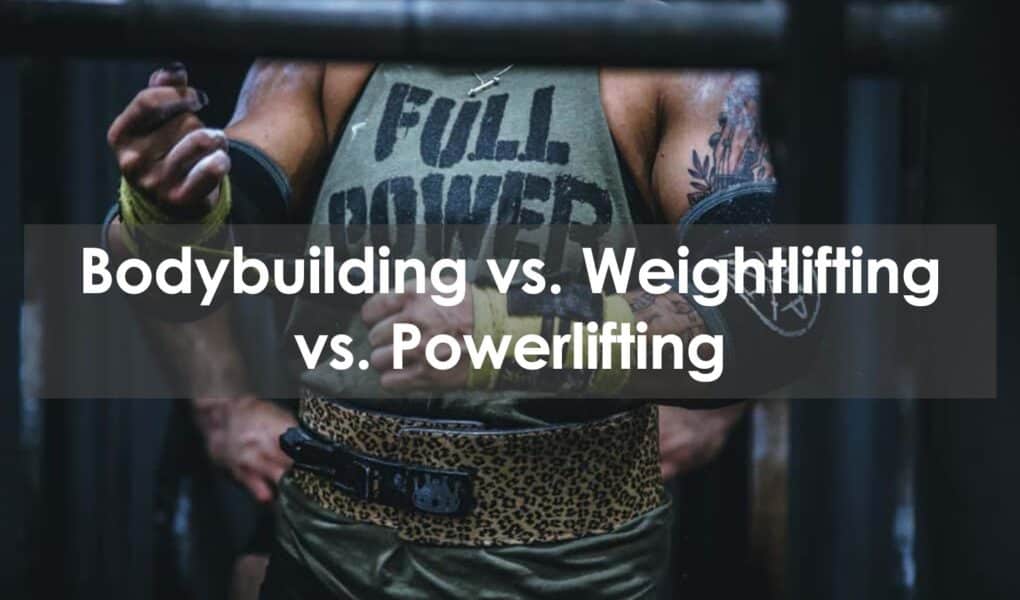When you are new to the gym and resistance training, everything seems to fall under the term “Bodybuilding”. If you see someone deadlifting; they’re a bodybuilder. If you see someone doing pull-ups; they’re a bodybuilder. If you see someone doing curls; they’re a bodybuilder.
This is due to the rise of famous stars such as Arnold Schwarzenegger, Ronnie Coleman, and even Sylvester Stallone. These are some of the names which helped bring gym life and the practice of bodybuilding into the mainstream.
However, not everything you see in the gym is “bodybuilding”. Bodybuilding is a sport that utilizes certain exercises and a form of training to meet its goals. So is powerlifting and the sport of weightlifting. All of these may use similar exercises but the intent behind the use dictates what sport they are in.
If you are just going to the gym for general health and fitness, it doesn’t really matter too much what you call your training program.
However, if you want to start getting serious with your physical training and perhaps even compete, it is important to know what the difference is between bodybuilding and other training you may hear of such as weightlifting and powerlifting.
This is similar to knowing the difference between a runner who competes in the 100m sprint and a marathoner. They both run, and there may be some crossover with they’re training but their end goal is very different
For one, knowing the differences between these three styles will dictate the intent of why you are picking up the barbell. This intent will then dictate your goals and how to train.
Related Post: 11 Best Barbells for Home Gym
Introduction to Bodybuilding
Contrary to popular belief, bodybuilding has little to do with strength training and everything about increasing muscle size. If this seems strange, you must realize that “strength” and “size” are two distinct variables that a muscle can possess. While there is a definite relationship between the two, they are not the same.
As the term implies, bodybuilding is a style of training that is focused on creating a body with an aesthetically appealing shape. They want to have a lot of mass with great muscle definition. This can be broken down into three major objectives.
- Increase muscle mass
- Have a low body fat percentage
- Have proportional muscles
Style of Training
In bodybuilding, the overall volume is king. Bodybuilders will use moderate weight for moderate reps to maximize volume while still giving their muscle fibers adequate stress. Further, bodybuilders tend to have a much larger selection of exercises for two reasons. The first being that they try to hit the muscles from every angle to maximize growth. Secondly, bodybuilders generally work “faster” with shorter rest periods and lower amounts of sets. This means that they have more time in the gym to perform more exercises.
Bodybuilders typically go to the gym more often, 5-6 times a week, when compared with other lifters. You are more likely to train with a routine that concentrates on a different body part on different days or sometimes even just one muscle.
In terms of exercise selections, bodybuilders do a lot of isolation exercises.
Fat loss will also be a major part of your programming as you are prepping for a bodybuilding competition. The last hallmark of bodybuilders is that they take their diets very seriously and know every calorie that they consume.
Who is Bodybuilding For?
Bodybuilding is the most popular style of training, whether people know it or not. Improving the aesthetics of one’s body is the most popular reason why people begin to go to the gym in the first place.
However, when we need to speak of bodybuilding in terms of your overall goals; This can be broken down into recreational and competitive.
Recreational bodybuilders are your average gym-goer. They are trying to improve their aesthetics but have no intention of competing. They are doing bodybuilding purely for self-gratification.
Competitive bodybuilders are those who are planning on competing in competitions at various levels.
You must be very confident and comfortable with yourself as you will need to stand on a bodybuilding stage while wearing relatively small pieces of clothing. In addition, you will need to spend time learning how to pose.
In order to seriously compete, you must give extreme dedication to both your training and diet. This can be a major roadblock as many people just aren’t willing, or able to dedicate the amount of time it requires in addition to restrictions placed on your life. This is especially true when you begin prepping for bodybuilding competitions.
All that being said, you don’t need to compete at high levels, or at all, to gain the benefits from bodybuilding. There is room for everybody of all different levels. Young, old, disabled, overweight…everyone can improve their body aesthetics.
Benefits of Bodybuilding
The biggest benefit of bodybuilding is going to be the main goal which is to achieve better body composition. Bigger muscles and less fat.
This in turn can have drastic secondary benefits like higher self-esteem, more self-confidence, and a potentially better social life.
Bodybuilders are notorious for healthy eating so you will learn a lot about counting macros as well as improving your cooking skills.
Expect to improve your cardiovascular system as well. Bodybuilding sticks out from other forms of strength sports in that bodybuilding requires a lot of volume. This means a lot of reps. Bodybuilders will routinely use different styles of lifting such as compound sets, supersets, and circuits. All these require an extension to the time you are lifting which will become increasingly taxing on the metabolic systems.
Bodybuilders are also more likely to do HIIT training too.
This doesn’t mean that no other styles of lifting do this also, just that it is more common in bodybuilding.
Getting Started on Bodybuilding
Getting started on bodybuilding is relatively easy as there is a ton of content for it. I would recommend picking up a copy of Dr. Brads Schoenfelds book titled “Science and Development of Hypertrophy” It looks like a textbook and is somewhat science-y. However, it is the most thorough a book can get on hypertrophy (bodybuilding) than can be relatively easy to understand for the general public.
Introduction to Weightlifting
Isn’t weightlifting what people do when they go to the gym? They lift weights? Lifting weights is known as weight lifting. The Olympic sport is known as weightlifting. The difference is in one space.
Olympic weightlifting is a sport that focuses on two lifts. The snatch and the clean and jerk. In competitions, the athlete’s main goal is to perform both movements with the heaviest amount of weight. Whoever lifts the heaviest wins.
Weightlifting can be performed among a wide variety of levels.
One area where weightlifting stands out is that it is currently the only strength sports (not counting track and field sports i.e. shot put) that is included in the Olympics.
From a performance perspective, the Olympic lifts are what we define as “power” exercises. In strength and conditioning, a very basic definition of “power” is to move the weight at an accelerated rate and high speed. For example, jumping is a power movement as it requires an explosive and fast movement to propel the body in the air. Olympic lifts require a great amount of explosive power to propel the weight through the air.
Even though aesthetics plays no role in weightlifting, athletes are still concerned with their diet. This is because Olympic lifters will compete in a certain weight category determined by their body weight at the time of competition. Therefore, weightlifters really have one major goal. That is to be as strong as possible in the snatch and clean in relation to their weight class.
Style of Training
Olympic weightlifters probably have the narrowest selection of exercises they perform. Other than the main lifts, there is some variance but a large portion of the lifts are variants or parts of the snatch and clean. They will also rarely do isolation exercises. This has led some to say that weightlifting training is boring which can be true if they are used to doing a wide variety of exercises. This a personal choice.
Further, all movements are chosen related to its benefit to the two Olympic lifts. For example, athletes will usually perform front squats rather than front squats. This is because, after the catch in the clean, the athlete must then perform a front squat.
Another good example is Olympic weightlifters will put much more focus on overhead pressing while you may rarely see them doing the bench press.
Olympic weight lifters may work with a range of weight from 70-95% 1RM.
However, they almost exclusively work with a low rep range and long rest periods.
Who is Weightlifting For?
Many people use the two weightlifting movements in their programs even though they have no desire to ever compete in the sport of weightlifting at any level.
For example, variations of the two movements are used quite extensively in the sport of CrossFit. Many athletes use forms of the snatch and clean in their programs as well due to the crossover to athletic performance.
On the other hand, if you are looking to go to the Olympics, weightlifting is for you as it is the only lifting sport in the Olympics.
Regardless, weightlifting is for anyone who wants to improve their explosive power and athleticism.
Another aspect to consider is that weightlifting is the most skilled and complex style of training. This makes the learning curve much longer and training intensive than other movements. Therefore, you need to be prepared to put in a lot of practice when you first start. You will also most likely need a strength coach who specializes in Olympic lifting
Benefits of Weightlifting
Weightlifting will improve your explosiveness and athleticism more so than any other type of training.
Weightlifters are infamous for being extremely strong but not looking like lifters. This is due to their style of training which is not ideal for hypertrophy when done exclusively.
However, you can easily add more hypertrophic training to weightlifting. Look at NFL linebackers who are huge but routinely utilize Olympic lifts. This will really be determined as to what level of training you want to compete in.
Getting Started on Weightlifting
Introduction to Powerlifting
While weightlifting is a power sport, the sport of powerlifting is a strength sport.
This again is a little confusing.
Contrary to weightlifting which consists of explosive and fast movements, the term “strength” can be thought of as “slow strength” movements.
The sport of powerlifting revolves around being able to lift the most weight in three movements often known as “The Big Three”
- Bench Press
- Squat
- Deadlift
Being that the main goal is to lift as much weight as possible in only these three lifts, a dedicated powerlifter will create a plan which revolves around their main lifts.
Similar to weightlifting, a dedicated powerlifter will sacrifice aesthetics for more strength. All of their movements will be used as a means to improve the lifts of The Big Three.
Style of Training
Similar to weightlifting, powerlifters compete in weight classes. However, powerlifters tend to have worse diet practices compared to other athletes. This is because much greater attention is given to those in the Open category and maximum absolute weight.
A powerlifter weight training will compose of their main lifts and variations which hit multiple muscle groups. In terms of isolation exercises, powerlifters will generally do more than weightlifters but less than bodybuilders.
Powerlifters will generally use heavy loads for lower reps and more sets. A typical powerlifting routine may have you do 7 sets of 2 reps on one lift. This is great for strength but will fall short in terms of building muscle mass when compared to bodybuilders. However, as mentioned above, many powerlifters will include hypertrophy training in their routine.
Powerlifting competitions are known for the high amount of energy they emit. This makes sense as all the athletes are putting out their maximal effort on 3 big lifts.
Who is Powerlifting For?
Powerlifting is for those who want to train for strength rather than aesthetics.
In terms of judging and winning competitions, powerlifting is more of a sport when compared to bodybuilding. This is because it is judged on objective, quantifiable measurements. Whoever lifts more wins. Period.
This is in comparison to bodybuilding whose success is subjective in that some people might like the way you look and others don’t. This is why some say that bodybuilding is more similar to a pageant in terms of judging.
Obviously, bodybuilders train hard and this is why I said in terms of judging so this is not taking away from what they do. It is merely to contrast the differences.
Another factor to consider is your health and any previous injuries.
Powerlifting requires you to put tremendous amounts of stress on the body. The risk of injury doing powerlifting is similar to contact sports such as football. While relatively low, it is higher than bodybuilding. If you have previously had any type of injuries, especially in the back and joints, you will want to be cautious.
Benefits of Powerlifting
The main benefit is going to be that it will make you strong. Real Strong.
Another benefit is powerlifters generally have more hypertrophy than weightlifters. Even though both are concerned with strength, the style of lifting done by powerlifters is generally more friendly for muscle growth.
One area where powerlifters suffer from bodybuilders is their conditioning. Powerlifters generally don’t see the same amount of volume and focus more on very heavy loads for 1-3 reps across many sets. While great for strength, it doesn’t do much for overall cardio work. Luckily, this problem has been addressed by many top powerlifters who encourage some type of cardio work that will have cross-over to powerlifting. This means performing a lot of sled work and carries.
Getting Started on Powerlifting
The Lifestyle
One thing that is usually not mentioned with these styles is the lifestyle and community that goes along with it. You may find that you are drawn to a specific group more so than the other. This may sound trivial, but it is a fundamental part of the sport.
Which One Is For You?
No style owns any lift or style of lifting. A powerlifter may do high reps like a bodybuilder and a weightlifter may do heavy deadlifts like a powerlifter. Your intent will dictate if you are a bodybuilder, powerlifter, or weightlifter.
I have my preferences but any method is great and will benefit both your health and quality of life. I tell all my clients that I don’t care what they do, just do something and give it 100% effort.
If you are training for general health, don’t think you can’t borrow something from all three styles. In fact, I personally believe that a mixture of training styles is best for the majority of people who may want to take their health and fitness seriously, but aren’t planning on competing. This can allow you to reap the benefits from all three styles while maintaining more variety.
Before you make a decision, mess around with all styles. Watch some Youtube videos, maybe check out some local competitions. If you just started training, you’ll need at least a year of proper experience before you really need to start focusing on a specific style.
Before you start any type of resistance training program, it is important to ensure that you do not have any medical or health issues which could make training dangerous.
Consult with a doctor or physician before you begin any type of resistance training.
Frequently Asked Questions
Are weightlifters stronger than bodybuilders?
Pound for pound, generally yes. Weightlifting is a strength sport while bodybuilding is an aesthetic sport.
Should I Bodybuild of Powerlift?
This is 100% up to the individual and your goals.
What is a Weightlifter?
A weightlifter is someone who participates in the sport of Olympic weightlifting. This sport consists of attempting to lift the maximal weight in the snatch and the clean and jerk.







